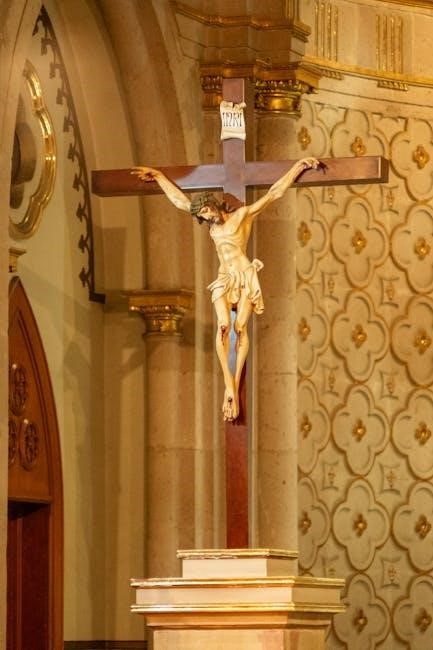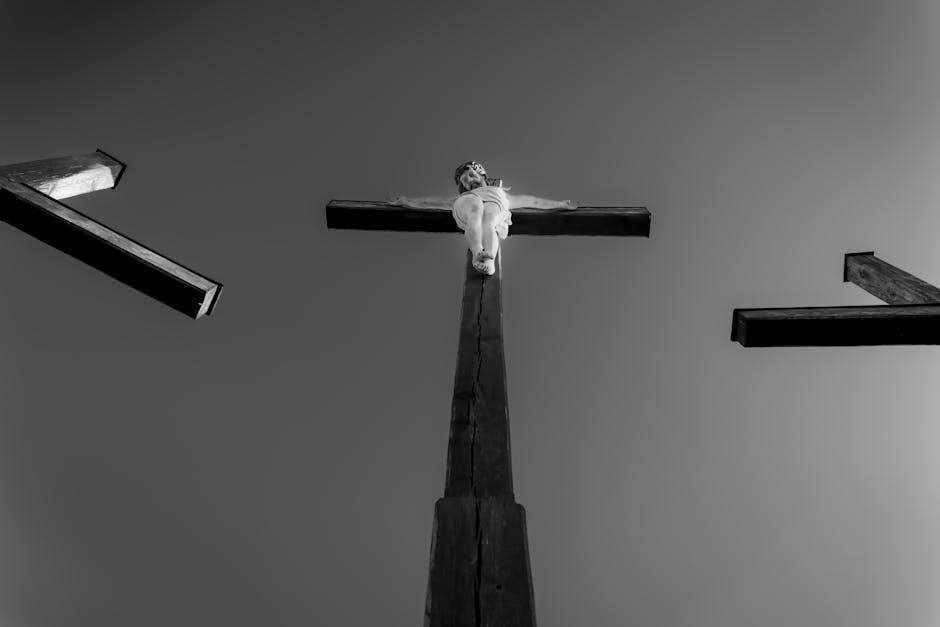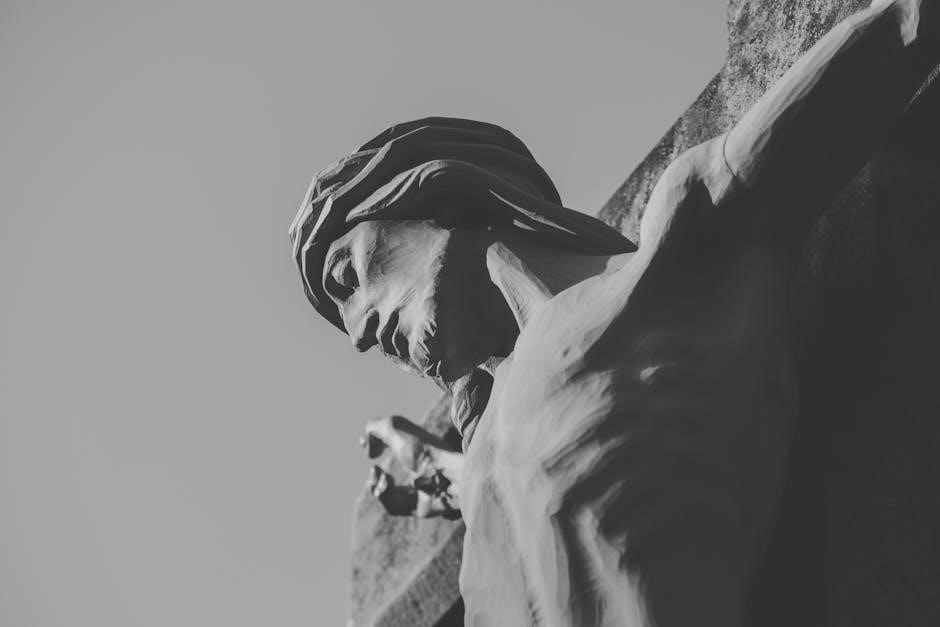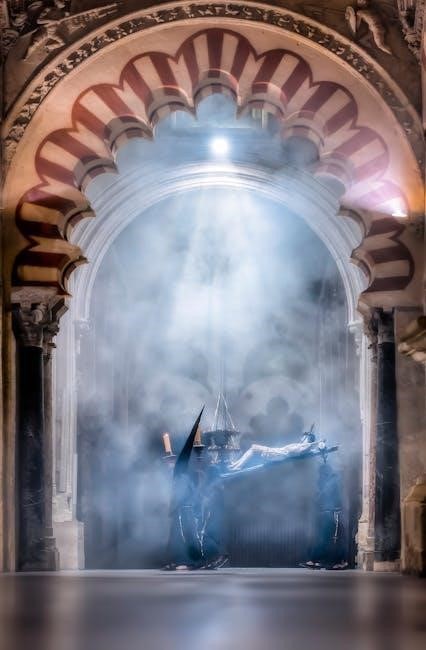The timeline of Jesus’ crucifixion and Passover is deeply interconnected, with events unfolding from His arrival in Bethany to the Resurrection, fulfilling biblical prophecy and symbolizing atonement.
a. Overview of the Timeline
The timeline of Jesus’ crucifixion and Passover spans key events from His arrival in Bethany six days before Passover to His Resurrection. It includes the Triumphal Entry into Jerusalem, the Last Supper (a Passover Seder), His prayer in Gethsemane, arrest, trials, crucifixion at Golgotha, and burial before the Sabbath. The Resurrection on the third day fulfills prophecy and highlights Jesus as the ultimate Passover Lamb, symbolizing redemption and atonement. This sequence is detailed in the Gospels, providing a chronological and theological framework for understanding the significance of these events.
b. Connection to Passover
Jesus’ crucifixion is deeply linked to the Passover, as He fulfilled the role of the ultimate Passover Lamb. In the Exodus, the lamb’s blood spared Israel’s firstborn, symbolizing redemption. Jesus’ sacrifice on the cross mirrored this, offering atonement for humanity’s sins. The Last Supper, a Passover Seder, and His crucifixion at the time of the Passover sacrifice (around 3 PM) underscore this connection. Jesus, as the Lamb of God, embodies the fulfillment of Old Testament prophecy, providing salvation through His death and Resurrection.
Key Events Leading to the Crucifixion
Key events include Jesus’ arrival in Bethany six days before Passover, His triumphal entry into Jerusalem, and the Last Supper, symbolizing His role as the Passover Lamb.
a. Arrival in Bethany Six Days Before Passover
Six days before Passover, Jesus arrived in Bethany, where Lazarus, whom He had raised from the dead, lived. A dinner was held in His honor, with Martha serving and Lazarus present. Mary anointed Jesus’ feet with costly perfume, an act of devotion and preparation for His burial. This event marked the beginning of Jesus’ final week, aligning with the Passover preparations and symbolizing His upcoming sacrifice as the Lamb of God. The gathering also drew a large crowd, further intensifying the religious leaders’ plot against Him.
b. Triumphal Entry into Jerusalem on the 10th of Nissan
On the 10th of Nissan, Jesus made a triumphant entry into Jerusalem, fulfilling Old Testament prophecies. As the people prepared for Passover, Jesus rode a donkey, symbolizing humility and peace. Crowds waved palm branches and shouted “Hosanna,” acknowledging Him as the Messiah. This event, recorded in Matthew 21:1-11, Mark 11:1-10, Luke 19:28-40, and John 12:12-19, marked the beginning of His public declaration as the Son of David. The timing aligned with Exodus 12:3, when Passover lambs were selected, further emphasizing Jesus’ role as the ultimate Passover Lamb.
The Last Supper
The Last Supper, held on the first day of Passover, was a profound moment where Jesus shared a final meal with His disciples, fulfilling the Passover Seder.
a. The Passover Seder
The Last Supper was a Passover Seder, a traditional Jewish meal commemorating Israel’s deliverance from Egypt. Jesus and His disciples observed this ritual, sharing unleavened bread, wine, and a roasted lamb. This symbolic meal deepened the disciples’ understanding of Jesus’ mission, as He reinterpreted the elements to represent His body and blood, fulfilling the Passover’s redemptive significance. The Seder’s focus on liberation and sacrifice aligned with Jesus’ role as the ultimate Passover Lamb, offering salvation through His impending crucifixion.
b. Institution of the Eucharist
During the Last Supper, a Passover Seder, Jesus instituted the Eucharist, a sacred ritual in Christian worship. He took bread, blessed it, and shared it with His disciples, saying, “This is My body.” Similarly, He took the cup of wine, declaring, “This cup is the new covenant in My blood.” This act transformed the Passover meal into a profound symbol of His sacrifice, establishing the Eucharist as a remembrance of His body and blood offered for humanity’s redemption, forever linking it to the Passover’s redemptive themes.
The Garden of Gethsemane
Jesu prayed in Gethsemane, experiencing deep emotional and spiritual struggle before His arrest, marking a pivotal moment in His journey toward crucifixion.
a. Jesus’ Prayer and Agony
In the Garden of Gethsemane, Jesus prayed intensely, experiencing profound emotional and spiritual distress. He begged God to remove the cup of suffering, yet submitted to His will. His disciples, despite their weakness, struggled to stay awake and support Him. This moment of agony showcased Jesus’ humanity and divine obedience, setting the stage for His arrest and the events leading to the crucifixion.
b. The Arrest and Betrayal by Judas
In Gethsemane, Judas betrayed Jesus with a kiss, identifying Him to the arresting party. The event occurred around 1:00 AM, as Judas led a group of Roman soldiers and temple guards. Despite Peter’s attempt to defend Jesus by cutting off a servant’s ear, Jesus healed the wound and submitted peacefully. The disciples fled in fear, fulfilling Jesus’ earlier prophecy. This act of betrayal marked the beginning of Jesus’ trials and the unfolding of His sacrificial journey toward crucifixion.

Trials of Jesus
Jesuss trials began with Annas, the former high priest, followed by Caiaphas and the Sanhedrin, where He faced false accusations and unlawful proceedings, highlighting the unjust process.
a. Trial Before Annas
Jesus was first brought before Annas, the former high priest and father-in-law of Caiaphas, where He endured questioning about His disciples and teachings. This initial trial set the tone for the subsequent proceedings, showcasing the religious leaders’ intent to discredit Him. The informal nature of this trial highlighted the political maneuvering within the priesthood, as Annas sought to gather evidence to justify further action. This event marked the beginning of a series of unlawful proceedings against Jesus, underscoring the corruption of the religious establishment.
b. Trial Before Caiaphas and the Sanhedrin
Following the trial before Annas, Jesus was taken to Caiaphas, the high priest, and the Sanhedrin. The council sought to convict Jesus under the charge of blasphemy, citing His claim to be the Son of God. False witnesses were brought forth, and under oath, Jesus affirmed His divine identity. This led the Sanhedrin to declare Him guilty, condemning Him to death. The trial’s illegality was evident, as it occurred at night without proper quorum, yet it fulfilled the religious leaders’ objective to eliminate Jesus as a perceived threat to their authority and traditions.

The Crucifixion
Jesus was crucified at Golgotha, nailed to the cross between two criminals. A sign reading “King of the Jews” was placed above Him. Darkness fell from noon to 3 PM as He bore the sins of humanity, fulfilling prophecy and offering redemption through His sacrifice.
a. Pontius Pilate’s Judgment
Pontius Pilate, the Roman governor, played a crucial role in Jesus’ crucifixion. After being accused by the Sanhedrin, Jesus was brought before Pilate, who questioned Him about the charges. Despite finding no guilt, Pilate hesitated due to political pressure and the insistence of the crowd. He famously washed his hands, symbolizing his attempted detachment from the verdict. Ultimately, Pilate sentenced Jesus to crucifixion, fulfilling the prophetic role of the Passover Lamb. This judgment occurred on Friday, April 15, 30 AD, between 1:00 AM and 1:30 AM, following His arrest in the Garden of Gethsemane.
b; The Crucifixion at Golgotha (9 AM to 3 PM)
Jesus was crucified at Golgotha, nailed to the cross between 9 AM and 3 PM. A sign above Him read “King of the Jews,” sparking mockery from onlookers. Soldiers gambled for His clothes, fulfilling prophecy. Darkness fell from noon to 3 PM, symbolizing divine judgment. Jesus uttered His final words, expressing thirst and surrender to God. His death marked the culmination of the Passover symbolism, as He became the ultimate sacrifice for humanity’s sins, aligning with the timing of the Passover lamb’s slaughter in Exodus.

Burial and Resurrection
Jesus was buried before sundown, fulfilling Jewish customs. His resurrection on the third day symbolized victory over death, aligning with Passover’s themes of liberation and divine fulfillment.
a. Burial Before the Sabbath
Jesus was hastily buried in a nearby tomb by Joseph of Arimathea and Nicodemus before the Sabbath began. His body, wrapped in linen with spices, rested in the tomb, fulfilling biblical prophecies and aligning with Passover customs. This act of burial, though rushed, demonstrated respect and preparation for the sacred Sabbath, while also setting the stage for His resurrection, symbolizing liberation and divine fulfillment.
b. Resurrection on the Third Day
The resurrection of Jesus on the third day marked the culmination of the crucifixion and Passover narrative. Early on Sunday morning, followers discovered the empty tomb, with Jesus appearing to Mary Magdalene and later to His disciples. This miraculous event symbolized victory over death and sin, fulfilling Old Testament prophecies and solidifying Jesus’ role as the ultimate Passover Lamb. The resurrection underscored the redemptive purpose of His sacrifice, offering eternal life and hope to humanity.

Theological Significance
The crucifixion and resurrection of Jesus represent the ultimate fulfillment of biblical prophecy, symbolizing atonement for humanity’s sins and establishing Jesus as the true Passover Lamb.
a. Jesus as the Passover Lamb
Jesus fulfilled the role of the Passover Lamb, symbolizing redemption and atonement. His arrival in Bethany six days before Passover aligned with the selection of the lamb (Exodus 12:3). Mary’s anointing of His feet in Bethany (John 12:1-8) marked Him as the Lamb of God. Jesus’ crucifixion coincided with the slaying of the Passover lambs, emphasizing His sacrifice for humanity’s sins. This connection underscores His divine purpose as the ultimate atonement, fulfilling Old Testament prophecies and offering salvation through His death and resurrection.
b. Fulfillment of Prophecy and Atonement
Jesus’ crucifixion and resurrection fulfilled numerous Old Testament prophecies, such as Psalm 22 and Isaiah 53, which foretold His suffering and sacrifice. His death served as the ultimate atonement for humanity’s sins, replacing the need for animal sacrifices. By dying on the cross, Jesus provided redemption, reconciling humanity with God. This act of atonement was central to the theological significance of His crucifixion, embodying God’s love and mercy while fulfilling the divine plan revealed throughout Scripture.
The crucifixion and resurrection of Jesus, deeply connected to Passover, fulfill prophecy and symbolize atonement, making this event central to Christian theology and humanity’s redemption.
a. Summary of the Crucifixion and Passover Connection
The crucifixion of Jesus is intricately linked to the Passover, symbolizing His role as the ultimate sacrifice for humanity’s sins. Jesus’ arrival in Bethany, the Last Supper, and His arrest align with Passover traditions, fulfilling ancient prophecies. The crucifixion on Nisan 14, the day of the Passover sacrifice, signifies Jesus as the Lamb of God, embodying redemption and forgiveness. This connection underscores the theological significance of Jesus’ death and resurrection as the fulfillment of God’s plan for salvation.
b. Significance in Christian Theology
The crucifixion and resurrection of Jesus are central to Christian theology, representing the ultimate act of divine love and redemption. Jesus, as the Passover Lamb, fulfilled Old Testament sacrifices, offering Himself to atone for humanity’s sins. This event embodies God’s plan for salvation, demonstrating His mercy and justice. The resurrection confirms Jesus’ divine authority and promises eternal life to believers, forming the cornerstone of Christian faith and hope. The connection between the crucifixion and Passover underscores the fulfillment of prophecy, reinforcing the belief in God’s redemptive plan for humanity.